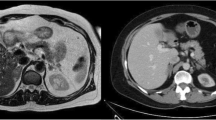Abstract
Background
Synchronous endoscopic bilateral adrenalectomy (BilA) can effectively provide definitive cure of hypercortisolism in ACTH-dependent Cushing’s syndrome and in primary adrenal bilateral disease. We compared three different approaches for BilA: transabdominal laparoscopic BilA (TL-BilA), simultaneous posterior retroperitoneoscopic BilA (PR-BilA), and robot-assisted BilA (RA-BilA).
Methods
All patients who underwent BilA between January 1999 and December 2012 at two referral centers (one performing TL-BilA and PR-BilA and one performing RA-BilA) were included. A comparative analysis was performed.
Results
Twenty-nine patients were included: 5 underwent TL-BilA, 11 underwent PR-BilA, and 13 underwent RA-BilA. No significant difference was found concerning age, gender, diagnosis, and previous abdominal surgery. No conversion to open approach was registered. Operative time was significantly shorter for the PR-BilA group than for the TL-BilA and RA-BilA groups (157.4 ± 54.6 vs 256.0 ± 43.4 vs 221.5 ± 42.2 min, respectively) (P < 0.001). No significant difference was found concerning intraoperative and postoperative complications rate and time to first flatus. Drains were used routinely after PR-BilA and TL-BilA and electively in four RA-BilA patients (P < 0.001). Hospital stay was longer in the TL-BilA and PR-BilA groups than in the RA-BilA group (12.0 ± 5.7 vs 10.8 ± 3.7 vs 4.4 ± 1.7 days, respectively) (P < 0.001). No recurrence or disease-related death was registered.
Conclusions
Operative time was significantly shorter in the PR-BilA group, because it eliminates the need to reposition the patient. The number of drains and the length of hospital stay were reduced after RA-BilA, but this was likely related to different management protocols in different settings. Because no significant difference was found in terms of postoperative outcome, none of the three operative approaches can be considered the preferable one.

Similar content being viewed by others
References
Newell-Price J (2008) Cushing’s syndrome. Clin Med 8:204–208
Acosta E, Pantoja JP, Famino R et al (1999) Laparoscopic versus open adrenalectomy in Cushing’s syndrome and disease. Surgery 126:1111–1116
Takata MC, Kebebew E, Clark OH et al (2008) Laparoscopic bilateral adrenalectomy: results for 30 consecutive cases. Surg Endosc 22:202–207
Chow JT, Thompson GB, Grant CS et al (2008) Bilateral laparoscopic adrenalectomy for corticotropin-dependent Cushing’s syndrome: a review of the Mayo Clinic experience. Clin Endocrinol (Oxf) 68:513–519
Thompson SK, Hayman AV, Ludlam WH et al (2007) Improved quality of life after bilateral laparoscopic adrenalectomy for Cushing’s disease: a 10-year experience. Ann Surg 245:790–794
Gumbs AA, Gagner M (2006) Laparoscopic adrenalectomy. Best Pract Res Clin Endocrinol Metab 20:483–499
Miccoli P, Materazzi G, Brauckhoff M et al (2011) No outcome differences between a laparoscopic and retroperitoneoscopic approach in synchronous bilateral adrenal surgery. World J Surg 35:2698–2702. doi:10.1007/s00268-011-1294-1
Walz MK, Alesina PF, Wenger FA et al (2006) Posterior retroperitoneoscopic adrenalectomy—results of 560 procedures in 520 patients. Surgery 140:943–948
Lombardi CP, Raffaelli M, De Crea C et al (2008) Endoscopic adrenalectomy: is there an optimal operative approach? Results of a single-center case–control study. Surgery 144:1008–1014
Lombardi CP, Raffaelli M, De Crea C et al (2011) ACTH-dependent Cushing syndrome: the potential benefits of simultaneous bilateral posterior retroperitoneoscopic adrenalectomy. Surgery 149:299–300
Brunaud L, Bresler L, Ayav A et al (2008) Robotic-assisted adrenalectomy: what advantages compared to lateral transperitoneal laparoscopic adrenalectomy? Am J Surg 195:433–438
Karabulut K, Agcaoglu O, Aliyev S et al (2012) Comparison of intraoperative time use and perioperative outcomes for robotic versus laparoscopic adrenalectomy. Surgery 151:537–542
Constantinides VA, Christakis I, Touska P et al (2012) Systematic review and meta-analysis of retroperitoneoscopic versus laparoscopic adrenalectomy. Br J Surg 99:1639–1648
Nigri G, Rosman AS, Petrucciani N et al (2013) Meta-analysis of trials comparing laparoscopic transperitoneal and retroperitoneal adrenalectomy. Surgery 153:111–119
Morino M, Beninca G, Giraudo G et al (2004) Robot-assisted vs laparoscopic adrenalectomy: a prospective randomized controlled trial. Surg Endosc 18:1742–1746
Dindo D, Demartines N, Clavien PA (2004) Classification of surgical complications. A new proposal with evaluation in a cohort of 6336 patients and results of a survey. Ann Surg 240:205–213
Gagner M, Pomp A, Heniford T et al (1997) Laparoscopic adrenalectomy: lessons learned from 100 consecutive procedures. Ann Surg 226:238–247
Walz MK, Peitgen K, Walz MV et al (2001) Posterior retroperitoneoscopic adrenalectomy: lessons learned within five years. World J Surg 25:728–734. doi:10.1007/s00268-001-0023-6
Brunaud L, Bresler L, Zarnegar R et al (2004) Does robotic adrenalectomy improve patient quality of life when compared to laparoscopic adrenalectomy? World J Surg 28:1180–1185. doi:10.1007/s00268-004-7559-1
Brunaud L, Germain A, Zarnegar R et al (2011) Robot-assisted adrenalectomy. Surg Laparosc Endosc Percutan Tech 21:248–254
Nordenström E, Westerdahl J, Hallgrimsson P et al (2011) A prospective study of 100 robotically assisted laparoscopic adrenalectomies. J Robotic Surg 5:127–131
Brunaud L, Ayav A, Zarnegar R et al (2008) Prospective evaluation of 100 robotic-assisted unilateral adrenalectomies. Surgery 144:995–1001
Hellman P, Linder F, Hennings J et al (2006) Bilateral adrenalectomy for ectopic Cushing’s syndrome—discussions on technique and indication. World J Surg 30:909–916. doi:10.1007/s00268-005-0347-8
Malley D, Boris R, Kaul S et al (2008) Synchronous bilateral adrenalectomy for adrenocorticotropic-dependent Cushing’s syndrome. JSLS 12:198–201
Barbash G, Glied SA (2010) New technology and health care costs—the case of robot-assisted surgery. N Engl J Med 63:701–704
Conflict of interest
No conflict of interest is declared for this paper.
Author information
Authors and Affiliations
Corresponding author
Rights and permissions
About this article
Cite this article
Raffaelli, M., Brunaud, L., De Crea, C. et al. Synchronous Bilateral Adrenalectomy for Cushing’s Syndrome: Laparoscopic Versus Posterior Retroperitoneoscopic Versus Robotic Approach. World J Surg 38, 709–715 (2014). https://doi.org/10.1007/s00268-013-2326-9
Published:
Issue Date:
DOI: https://doi.org/10.1007/s00268-013-2326-9




